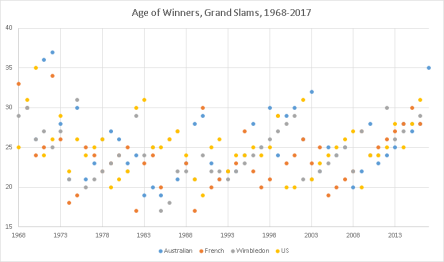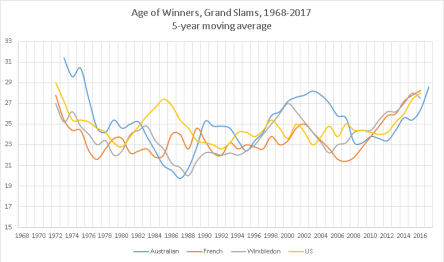
Roger Federer is a phenomenal player. He holds more Grand Slam titles than any other man in the history of tennis. His latest victory at the Australian Open was his 18th. Pete Sampras and Rafael Nadal lag behind on 14 each. Federer’s most recent triumph was remarkable not merely for adding to his already dominating total, but due to his age.
Winning the Australian Open men’s singles at the age of 35, Roger Federer has justly been acclaimed as one of the oldest champions of a tennis Grand Slam tournament. In an era of increasing power and speed, with the punishing schedule of competitions taking its toll of exhaustion and injury on players of all ages, male winners over the age of 30 are seen as something of a rarity. (While not ignoring the achievements of female players, not least the still-unstoppable force of the Williams sisters, here I will be considering the men’s game. I shall also be concentrating on singles.)
Federer is far from being the oldest champion. In 1909 the 41-year-old Arthur Gore triumphed in the Gentlemen’s Singles at Wimbledon. Indeed, he competed in his final tournament aged 52, far beyond the usual retirement age in the modern game. But that was a different time, when the players were amateurs and the game far slower. Most tennis records therefore start with the Open Era in 1968, when professional players became eligible to play at the major tournaments for the first time.
Even then, Roger Federer is not the oldest Grand Slam winner. That honour belongs to the extraordinary Ken Rosewall, who not only won the Australian Open in 1972 aged 37, but two years later finished runner-up at both Wimbledon and the US Open. He competed into his 40s.
Are these just physical and mental anomalies in a sport dominated by younger players, or do champions need to be matured?
According to The Economist (‘Senior Slammers: Roger Federer and Serena Williams defy age at the Australian Open’, 29 January 2017), older players are back with a vengeance. It suggests that Federer’s victory is the culmination of a growing trend for players to continue to excel into their 30s. We are told that the average age of a top-100 ATP player is currently 28.6 (in 1990 it was 24.6). But while this tells us that professional players are retiring later, it does not help us to establish whether older players have a better chance at succeeding at the highest level.
To test this, I have made an analysis of the ages of winners of the four Grand Slams from the start of the Open Era to the present (including Federer’s recent win in Australia) (Chart 1). This seems to suggest that players such as Rosewall and Federer are anomalies, and that throughout the period winners seem to be predominantly aged in their 20s. Teenagers and older players are equally unusual.

Chart 1
Analysing this data further, we see that in all the main measures of averages (mean, median, and mode) the average age of Grand Slam winners is 24. Looking at winners arranged by age there is a definite curve showing a small number from age 17 with a peak at age 24 (14% of the total); there is then a tailing off with players aged over 32 accounting for only 4%. Even when we discount players who won multiple tournaments in a particular year the same general pattern remains (Chart 2).

Chart 2
The picture changes slightly, however, if we take our original data and apply a 5-year moving average to it. A moving average enables us to see how different subsets of the overall data behave (Chart 3). This gives us quite a different picture. While the general grouping throughout the Open Era has still been solidly around victors in their mid-20s, there is a sharp decline in the early 1970s accounted largely by the ageing Ken Rosewall being succeeded by a younger generation of players. A more gradual and consistent rise is also visible from the mid-2000s to the present, with an average age increase of 23 to 28.

Chart 3
This does not explain how and why older players are successful. Escaping injury and retaining a high level of fitness are key, but the accumulation of stamina and experience must have a role to play. It is natural for mental resilience to build up over time and for a player to build up an intimate acquaintance with their major opponents’ games and styles. Whatever the reasons, the trend towards later success announced by The Economist appears well founded.
It remains to be seen whether Roger Federer’s Indian summer will continue, but if this year’s Australian Open is anything to go by, we are likely to be rewarded with more interesting tennis from our older players.